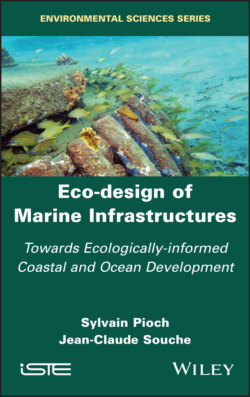Читать книгу Eco-design of Marine Infrastructures - Sylvain Pioch - Страница 14
1.1. Principles of maritime eco-design
ОглавлениеThe actions taken to allow for the “natural” environment (we will use this term here in relation to the word “ecosystem”) for the operation of maritime works are varied. In the case of ports, these include the control and reduction of discharges, energy, sediment, waste and water management, environmental management plans (compliant since 2013), natural infrastructure master plans – including a natural heritage master plan – and Natura 2000 operators within the port perimeter (e.g. the Grand Port Maritime of Dunkirk).
At the same time, several tools designed to provide (voluntary) environmental certification are also available to project owners: AFAQ Clean Ports, ISO 14001, Blue Flag and the latest “Clean Port” certification active in biodiversity3, in March 2018. These certifications are often accompanied by communication programs, such as the “Green Port”4, “Year of Biodiversity” and “Port Biodiversity Index”, or information panels and stands proposed by the ports’ sustainable development departments, suppliers of “eco-” equipment or operators (Figure 1.1).
Figure 1.1. Public presentation panel on port biodiversity in the port of Kernével, one of the first two ports in Brittany to be certified “Clean Ports Active in Biodiversity”5 in 2018 (photo: ©APPB)
Political actions or the dissemination of good environmental practices have been strengthened in recent years. At the international level, for example, we can cite the Working with Nature program (from the International Association of Ports and Canals, 2008), based in particular on the experience of Port 2000 in Le Havre and the numerous guides produced PIANC6 (2011a, 2019, 2020); the World Harbour Project7 (Steinberg et al. 2016), which brings together 15 ports around the issues of ecological engineering, nature-based solutions and the resilience of natural port environments; at the European level, the CWA 16987 (Clean Harbour Guidelines); and at the national level, the reflections initiated as part of the Grenelle mission on the “Port of the Future” (led by CEREMA8), or regional variations, such as for the major seaport of Marseilles and the “GIREL” 9 research program, which was carried out in 2010.
In spite of these virtuous impulses, in the field, during the first design phases of a project, the objectives are primarily to propose a structure that meets technical constraints (resistance, durability) with a controlled cost, aligned with socio-economic objectives that meet a functional need: a marina or a commercial port, an offshore wind turbine, a breakwater, an offshore wastewater treatment plant, etc. The environmental question is applied to justificatory and secondary considerations which are dealt with once the technical and socio-economic choices have been made, under regulatory “constraint” (Airoldi et al. 2021).
This is where the purpose of eco-design, or oekodesign10, takes root, for its objective is to design a project, from sketch or feasibility phases (within the meaning of Act no. 85-704 of July 12, 1985, on public contracting and its relationship with private contracting, known as the MOP Act), according to ecological performance or co-benefit objectives. The aim is not to “wipe the slate clean” for the past but, based on technical engineering knowledge, to introduce biophysical considerations, in connection with the need to protect and develop the natural environment in the project to develop the sea.
